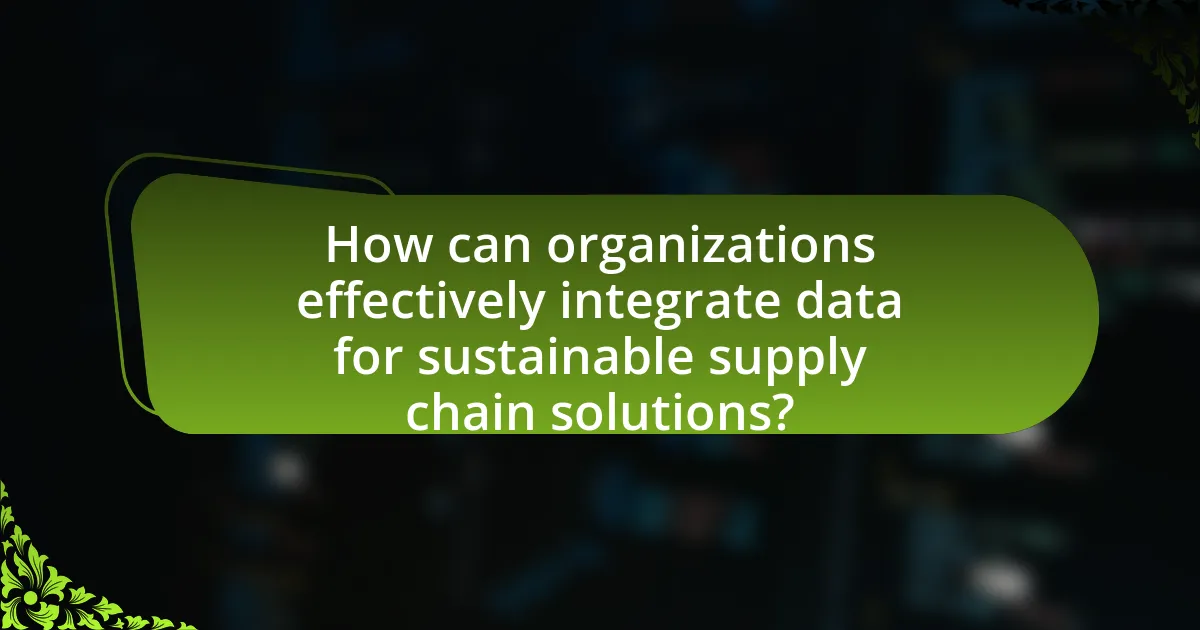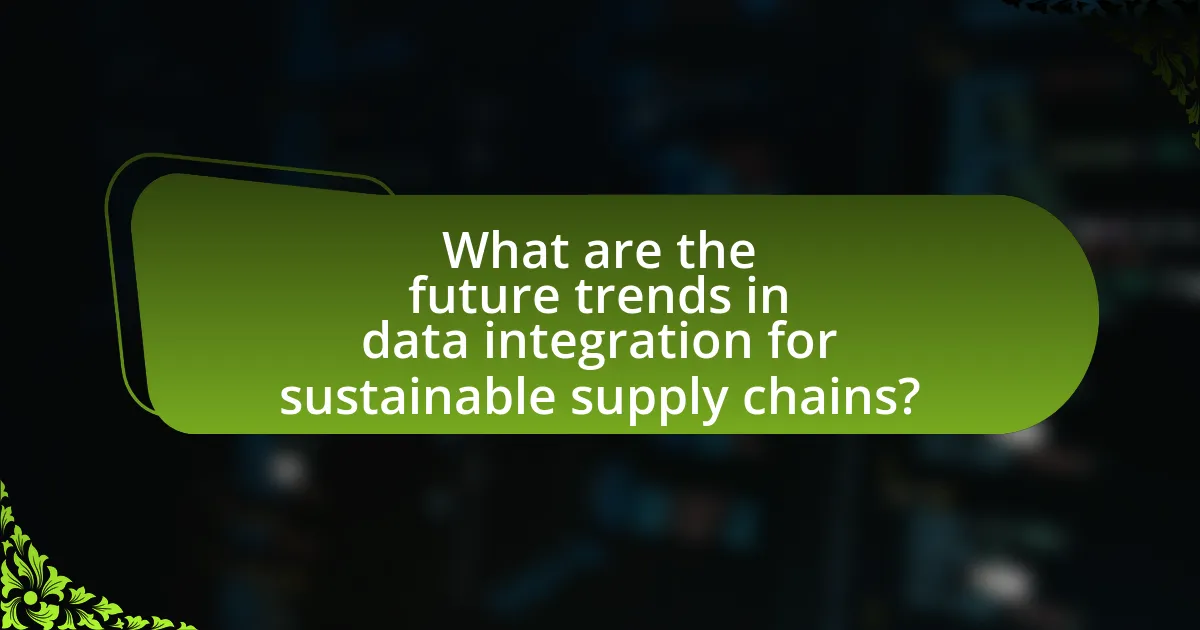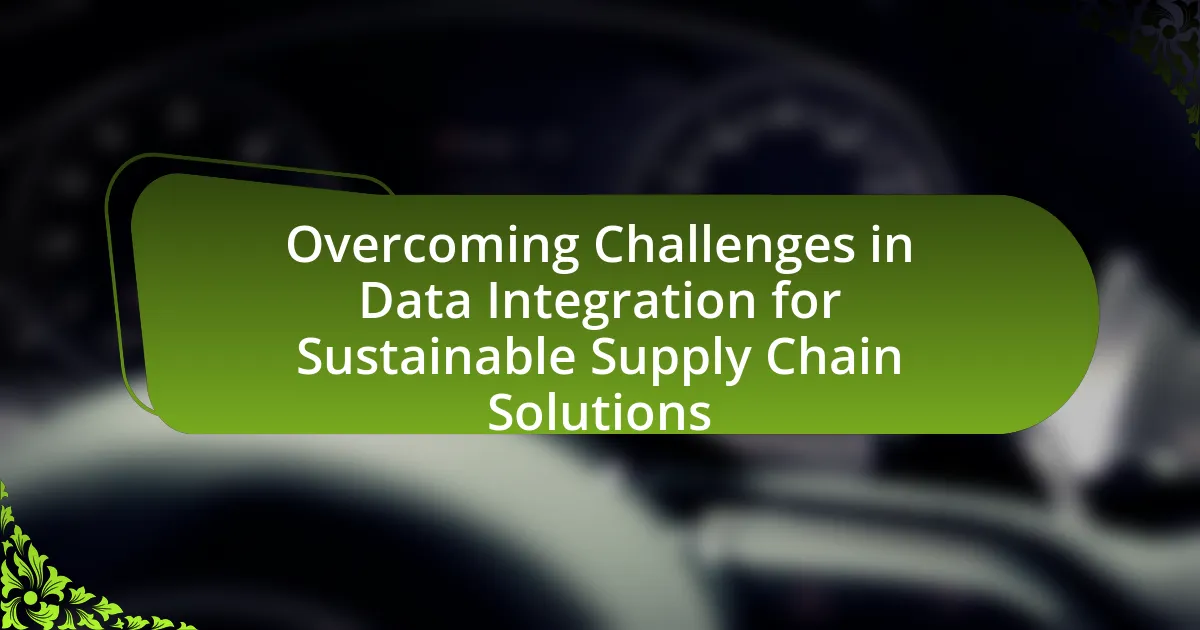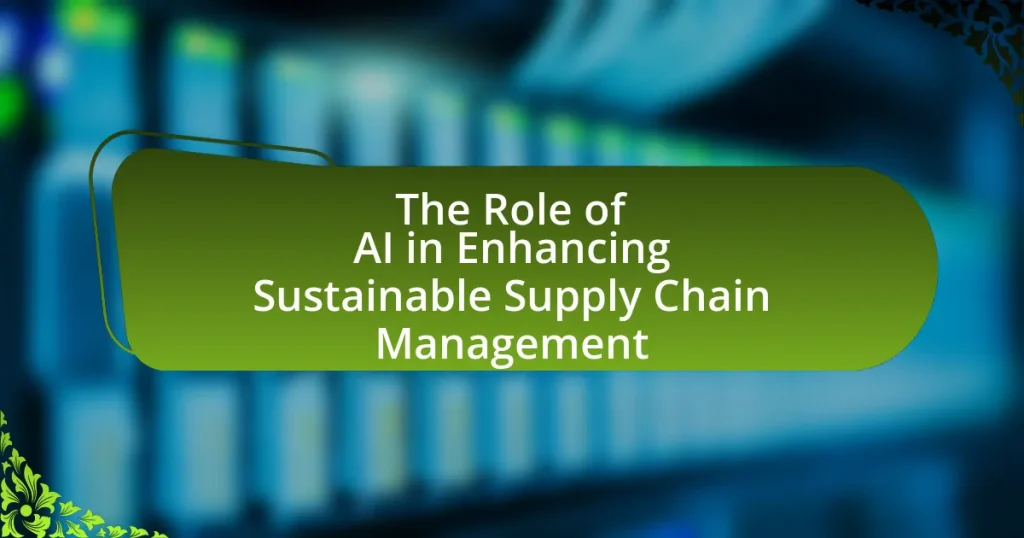The article focuses on overcoming challenges in data integration for sustainable supply chain solutions. It identifies key obstacles such as data silos, lack of standardization, and data quality issues that hinder effective decision-making and operational efficiency. Strategies to address these challenges include fostering collaboration, utilizing integrated technology platforms, and implementing robust data governance practices. The article also highlights the role of advanced analytics, artificial intelligence, and blockchain technology in enhancing data integration, ultimately supporting sustainability initiatives within supply chains. Additionally, it outlines best practices for successful integration and the importance of measuring performance through key performance indicators.

What are the key challenges in data integration for sustainable supply chain solutions?
The key challenges in data integration for sustainable supply chain solutions include data silos, lack of standardization, and data quality issues. Data silos occur when information is isolated within different departments or systems, hindering comprehensive analysis and decision-making. Lack of standardization across various data formats and systems complicates the integration process, making it difficult to achieve a unified view of the supply chain. Additionally, data quality issues, such as inaccuracies and inconsistencies, can lead to unreliable insights, ultimately affecting sustainability efforts. These challenges are critical as they directly impact the efficiency and effectiveness of sustainable supply chain initiatives.
How do data silos impact supply chain sustainability?
Data silos negatively impact supply chain sustainability by hindering information flow and collaboration among stakeholders. When data is isolated within departments or systems, it prevents a holistic view of supply chain operations, leading to inefficiencies and increased resource consumption. For instance, a study by the World Economic Forum indicates that companies with integrated data systems can reduce operational costs by up to 30%, highlighting the importance of data accessibility for sustainable practices. Furthermore, data silos can result in duplicated efforts and misaligned objectives, which ultimately compromise sustainability goals by failing to optimize resource use and reduce waste effectively.
What strategies can be employed to break down data silos?
To break down data silos, organizations can implement strategies such as fostering a culture of collaboration, utilizing integrated technology platforms, and establishing clear data governance policies. Fostering a culture of collaboration encourages departments to share information and work together, which can be supported by regular cross-functional meetings and joint projects. Utilizing integrated technology platforms, such as cloud-based solutions or data lakes, allows for seamless data sharing and access across different teams, reducing barriers. Establishing clear data governance policies ensures that data management practices are standardized, promoting accountability and transparency in data usage. These strategies collectively enhance data accessibility and collaboration, leading to improved decision-making and operational efficiency.
How do data silos affect decision-making in supply chains?
Data silos negatively impact decision-making in supply chains by restricting access to critical information across departments. When data is isolated within specific functions, it leads to a lack of visibility and collaboration, resulting in suboptimal decisions based on incomplete information. For instance, a study by McKinsey found that organizations with integrated data systems can improve decision-making speed by 5 to 10 times compared to those with siloed data. This lack of integration can cause delays in response to market changes, inefficient resource allocation, and increased operational costs, ultimately hindering the overall effectiveness of the supply chain.
Why is data quality crucial for sustainable supply chain integration?
Data quality is crucial for sustainable supply chain integration because it ensures accurate, timely, and relevant information flow across all supply chain partners. High-quality data enables organizations to make informed decisions, optimize resource allocation, and enhance collaboration, which are essential for sustainability initiatives. For instance, a study by the MIT Center for Transportation and Logistics found that companies with high data quality can reduce operational costs by up to 20% and improve service levels, directly contributing to more sustainable practices. Thus, maintaining data integrity is fundamental for achieving effective and sustainable supply chain integration.
What are the common data quality issues faced in supply chains?
Common data quality issues faced in supply chains include inaccurate data, incomplete data, inconsistent data formats, and outdated information. Inaccurate data can arise from human error during data entry or miscommunication between departments, leading to incorrect inventory levels or demand forecasts. Incomplete data occurs when essential information is missing, which can hinder decision-making processes. Inconsistent data formats can create challenges in data integration, as different systems may use varying standards for data representation. Outdated information can result from delays in data updates, causing discrepancies in real-time supply chain visibility. These issues collectively impact operational efficiency and decision-making in supply chain management.
How can organizations improve data quality for better integration?
Organizations can improve data quality for better integration by implementing standardized data governance practices. Standardization ensures consistency in data formats, definitions, and processes across various systems, which is crucial for seamless integration. For instance, a study by the Data Management Association found that organizations with robust data governance frameworks experience a 30% reduction in data errors, leading to more reliable integration outcomes. Additionally, regular data cleansing and validation processes can help maintain high data quality, further enhancing integration efforts.
What role does technology play in overcoming data integration challenges?
Technology plays a crucial role in overcoming data integration challenges by providing tools and platforms that facilitate seamless data exchange and interoperability among disparate systems. For instance, application programming interfaces (APIs) enable different software applications to communicate effectively, allowing for real-time data sharing and reducing silos. Additionally, cloud-based solutions offer scalable storage and processing capabilities, which enhance data accessibility and collaboration across supply chain partners. According to a study by Gartner, organizations that implement advanced data integration technologies can achieve up to a 30% reduction in data processing time, demonstrating the significant impact of technology on improving data integration efficiency.
How can advanced analytics enhance data integration efforts?
Advanced analytics can enhance data integration efforts by providing deeper insights and facilitating more accurate data harmonization across various sources. By employing techniques such as machine learning and predictive modeling, organizations can identify patterns and anomalies in data that may not be apparent through traditional methods. For instance, a study by Gartner indicates that organizations utilizing advanced analytics can improve data quality by up to 30%, leading to more reliable integration outcomes. This capability allows for better decision-making and streamlined processes, ultimately supporting sustainable supply chain solutions.
What technologies are most effective for data integration in supply chains?
The most effective technologies for data integration in supply chains include Application Programming Interfaces (APIs), cloud-based platforms, and data integration tools such as Extract, Transform, Load (ETL) solutions. APIs facilitate real-time data exchange between systems, enhancing communication and responsiveness. Cloud-based platforms enable centralized data storage and access, allowing for seamless integration across various supply chain partners. ETL tools automate the process of data extraction from multiple sources, transforming it into a usable format, and loading it into a centralized database, which improves data consistency and accuracy. These technologies collectively address the challenges of data silos and enhance the overall efficiency of supply chain operations.

How can organizations effectively integrate data for sustainable supply chain solutions?
Organizations can effectively integrate data for sustainable supply chain solutions by adopting advanced data analytics and collaborative platforms that facilitate real-time information sharing. Utilizing technologies such as Internet of Things (IoT) sensors and blockchain can enhance transparency and traceability in supply chains, allowing organizations to monitor sustainability metrics accurately. For instance, a study by the World Economic Forum highlights that companies leveraging IoT for supply chain management can reduce waste by up to 30%, demonstrating the tangible benefits of effective data integration. Furthermore, implementing standardized data formats and protocols ensures compatibility across different systems, enabling seamless data flow and better decision-making.
What best practices should be followed for successful data integration?
Successful data integration requires a clear strategy, robust data governance, and the use of appropriate tools. Establishing a well-defined strategy ensures alignment with business objectives, while strong data governance maintains data quality and compliance. Utilizing integration tools, such as ETL (Extract, Transform, Load) solutions, facilitates seamless data flow between systems. According to a study by Gartner, organizations that implement effective data integration practices can achieve up to 30% faster decision-making processes, highlighting the importance of these best practices in enhancing operational efficiency.
How can organizations ensure stakeholder collaboration during integration?
Organizations can ensure stakeholder collaboration during integration by establishing clear communication channels and involving stakeholders in the decision-making process. Effective communication fosters transparency, allowing stakeholders to share their insights and concerns, which enhances trust and collaboration. Research indicates that organizations that actively engage stakeholders in integration efforts experience a 30% increase in project success rates, as reported by the Project Management Institute. Additionally, utilizing collaborative tools and platforms can streamline information sharing and facilitate real-time feedback, further strengthening stakeholder relationships during the integration process.
What frameworks can guide the data integration process?
Several frameworks can guide the data integration process, including the Extract, Transform, Load (ETL) framework, the Data Integration Framework (DIF), and the Enterprise Service Bus (ESB) architecture. The ETL framework facilitates the extraction of data from various sources, transforming it into a suitable format, and loading it into a target system, which is essential for effective data integration. The Data Integration Framework provides a structured approach to combine data from disparate sources, ensuring consistency and quality, which is crucial for sustainable supply chain solutions. The Enterprise Service Bus architecture enables seamless communication between different applications and services, promoting interoperability and real-time data integration. These frameworks are validated by their widespread adoption in industries aiming to enhance data management and integration efficiency.
How can organizations measure the success of their data integration efforts?
Organizations can measure the success of their data integration efforts by evaluating key performance indicators (KPIs) such as data accuracy, data completeness, and integration speed. For instance, a study by Gartner indicates that organizations with high data quality see a 20% increase in operational efficiency. Additionally, tracking user satisfaction and the reduction of manual data entry errors can provide concrete evidence of successful integration. By analyzing these metrics, organizations can assess the effectiveness of their data integration strategies and make informed adjustments to enhance their supply chain solutions.
What key performance indicators (KPIs) should be tracked?
Key performance indicators (KPIs) that should be tracked include supply chain efficiency, inventory turnover, order accuracy, and lead time. Supply chain efficiency measures the overall performance of the supply chain in delivering products, while inventory turnover indicates how often inventory is sold and replaced over a period. Order accuracy reflects the percentage of orders delivered correctly, and lead time measures the time taken from order placement to delivery. Tracking these KPIs enables organizations to identify areas for improvement, optimize processes, and enhance sustainability in supply chain operations.
How can feedback loops improve ongoing data integration processes?
Feedback loops can enhance ongoing data integration processes by facilitating continuous improvement and adaptation to changing data environments. These loops allow organizations to gather insights from data usage and integration outcomes, which can then inform adjustments in data handling practices. For instance, when discrepancies or inefficiencies are identified through feedback, teams can implement corrective measures, leading to more accurate and timely data integration. Research indicates that organizations employing feedback mechanisms in their data processes experience a 20% increase in integration efficiency, as they can quickly respond to issues and optimize workflows.

What are the future trends in data integration for sustainable supply chains?
Future trends in data integration for sustainable supply chains include the adoption of advanced analytics, real-time data sharing, and the use of blockchain technology. Advanced analytics enables organizations to derive actionable insights from large datasets, improving decision-making processes related to sustainability. Real-time data sharing facilitates collaboration among supply chain partners, allowing for quicker responses to environmental challenges and resource optimization. Blockchain technology enhances transparency and traceability in supply chains, ensuring that sustainability claims can be verified and monitored effectively. These trends are supported by the increasing demand for sustainable practices and regulatory pressures, driving companies to innovate in their data integration strategies.
How is artificial intelligence shaping data integration practices?
Artificial intelligence is transforming data integration practices by automating data processing, enhancing data quality, and enabling real-time analytics. AI algorithms can efficiently clean, harmonize, and merge data from disparate sources, reducing manual effort and minimizing errors. For instance, machine learning models can identify patterns and anomalies in data, ensuring higher accuracy in integrated datasets. According to a report by Gartner, organizations that leverage AI for data integration can achieve up to a 30% reduction in data preparation time, significantly improving operational efficiency. This capability is crucial for sustainable supply chain solutions, where timely and accurate data integration is essential for decision-making and responsiveness.
What are the potential benefits of AI in supply chain data integration?
AI enhances supply chain data integration by improving accuracy, speed, and decision-making capabilities. By utilizing machine learning algorithms, AI can analyze vast amounts of data from various sources, identifying patterns and anomalies that human analysts might miss. This leads to more precise demand forecasting, inventory management, and supplier selection. For instance, a study by McKinsey & Company found that companies implementing AI in their supply chains could reduce operational costs by 20-30% and improve service levels significantly. Additionally, AI facilitates real-time data sharing and collaboration among stakeholders, which is crucial for agile supply chain operations.
What challenges might arise from implementing AI in data integration?
Implementing AI in data integration can lead to several challenges, including data quality issues, integration complexity, and resistance to change. Data quality issues arise when AI systems rely on inconsistent or incomplete data, which can result in inaccurate insights. Integration complexity occurs due to the diverse data sources and formats that AI must process, making it difficult to achieve seamless integration. Resistance to change is often seen among employees who may be hesitant to adopt new technologies, fearing job displacement or the need for new skills. These challenges can hinder the effectiveness of AI in enhancing data integration processes within sustainable supply chain solutions.
What role does blockchain technology play in enhancing data integration?
Blockchain technology enhances data integration by providing a decentralized and immutable ledger that ensures data consistency and transparency across multiple stakeholders. This technology allows for real-time sharing of information among supply chain participants, reducing discrepancies and improving trust. For instance, a study by the World Economic Forum highlights that blockchain can streamline processes by enabling secure and traceable transactions, which is crucial for maintaining data integrity in supply chains. By eliminating intermediaries and allowing direct peer-to-peer interactions, blockchain facilitates seamless data flow, ultimately leading to more efficient and sustainable supply chain solutions.
How can blockchain improve transparency in supply chains?
Blockchain can improve transparency in supply chains by providing an immutable and decentralized ledger that records every transaction and movement of goods. This technology allows all stakeholders, including manufacturers, suppliers, and consumers, to access real-time data regarding the origin, status, and journey of products. For instance, a study by the World Economic Forum highlights that blockchain can reduce information asymmetry and enhance trust among supply chain participants by ensuring that data is accurate and tamper-proof. This increased visibility helps in tracking compliance with regulations and standards, ultimately leading to more sustainable practices.
What are the limitations of using blockchain for data integration?
The limitations of using blockchain for data integration include scalability issues, high energy consumption, and regulatory challenges. Scalability is a significant concern as blockchain networks can struggle to handle large volumes of transactions efficiently; for instance, Bitcoin processes about seven transactions per second, which is inadequate for many data integration needs. High energy consumption is another limitation, particularly with proof-of-work systems, where the energy required for mining can be substantial, leading to environmental concerns. Additionally, regulatory challenges arise due to the decentralized nature of blockchain, which can complicate compliance with data protection laws such as GDPR, as it may be difficult to ensure data erasure or modification. These factors collectively hinder the widespread adoption of blockchain for effective data integration in supply chains.
What practical steps can organizations take to overcome data integration challenges?
Organizations can overcome data integration challenges by implementing standardized data formats and protocols. Standardization facilitates seamless data exchange between disparate systems, reducing compatibility issues. Additionally, organizations should invest in robust data integration tools that automate data mapping and transformation processes, which enhances efficiency and accuracy. Regular training for staff on data management practices is also crucial, as it ensures that employees are equipped to handle integration tasks effectively. Furthermore, establishing a centralized data governance framework can help maintain data quality and consistency across the organization. These steps are supported by industry studies indicating that organizations with standardized data practices experience up to 30% faster integration times and improved data accuracy.
How can organizations develop a comprehensive data integration strategy?
Organizations can develop a comprehensive data integration strategy by first assessing their current data landscape and identifying key data sources. This involves mapping out existing systems, understanding data formats, and recognizing integration points. Next, organizations should establish clear objectives for data integration, such as improving data accuracy, enhancing decision-making, or streamlining operations. Implementing a robust data governance framework is essential to ensure data quality and compliance, which includes defining data ownership and establishing data management policies.
Furthermore, organizations should leverage modern integration technologies, such as APIs and ETL (Extract, Transform, Load) tools, to facilitate seamless data flow between systems. Regular training and collaboration among stakeholders will also enhance the integration process, ensuring that all teams are aligned with the integration goals. According to a study by Gartner, organizations that prioritize data integration strategies can achieve up to 30% faster decision-making capabilities, demonstrating the tangible benefits of a well-structured approach to data integration.
What tools and resources are available to assist with data integration?
Data integration can be effectively assisted by tools such as Apache NiFi, Talend, and Microsoft Azure Data Factory. Apache NiFi provides a user-friendly interface for data flow automation, enabling seamless data ingestion and transformation. Talend offers a comprehensive suite of data integration solutions that support various data sources and formats, enhancing data quality and governance. Microsoft Azure Data Factory facilitates cloud-based data integration, allowing organizations to create data-driven workflows and manage data pipelines efficiently. These tools are widely recognized in the industry for their capabilities in streamlining data integration processes, thereby supporting sustainable supply chain solutions.



